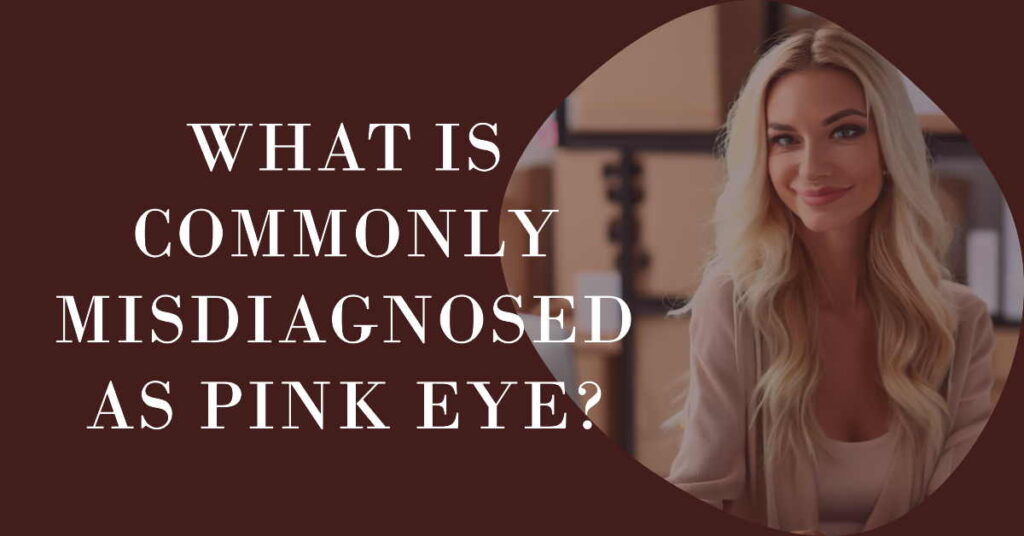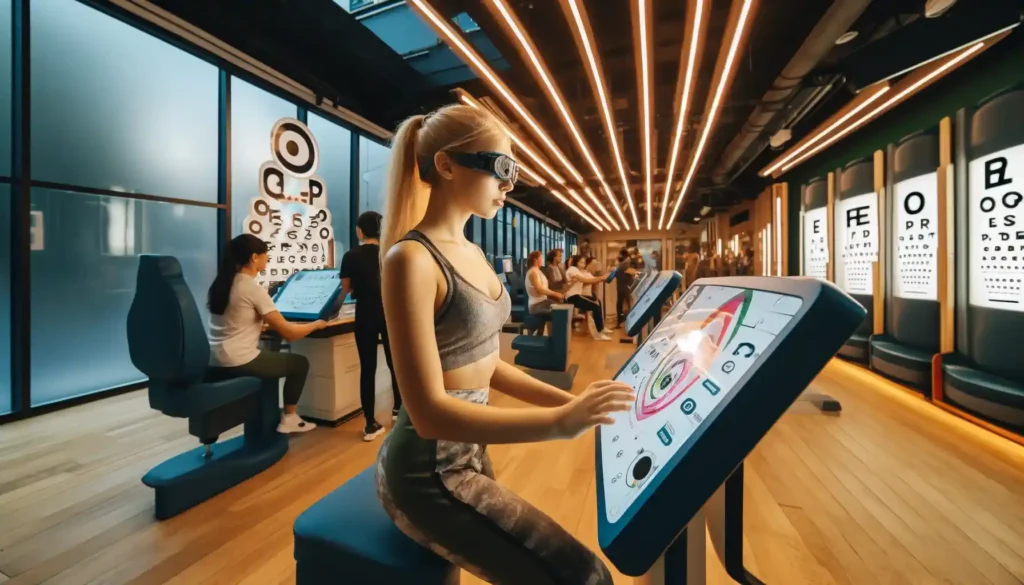Pink Eye: Unraveling Commonly Misdiagnosed Eye Conditions. The red, itchy, and often painful eyes associated with conjunctivitis, commonly known as pink eye, are symptoms that prompt many to assume a straightforward diagnosis. However, several other eye conditions can mimic the signs of pink eye, leading to misdiagnosis and delayed proper treatment. Understanding these conditions is crucial for accurate diagnosis and timely intervention, ensuring the preservation of ocular health.

1. Allergic Conjunctivitis
Similar to bacterial or viral conjunctivitis, allergic conjunctivitis can cause redness, itching, and swelling. It occurs due to allergens like pollen, dust, or pet dander, leading to an allergic reaction in the eyes.
2. Dry Eye Syndrome
Chronic dry eyes can cause redness and irritation, often mistaken for pink eye. Dry eye syndrome occurs when the eyes do not produce enough tears or the tears evaporate too quickly, leading to discomfort and inflammation.
3. Acute Glaucoma
Acute glaucoma is a serious condition where increased pressure in the eye can cause sudden redness, blurred vision, and intense eye pain. If not treated promptly, it can lead to permanent vision loss.
4. Uveitis
Uveitis, a condition not commonly heard of, yet significant in its impact, is the inflammation of the uvea, the eye’s middle layer. This crucial part of the eye includes the iris, ciliary body, and choroid, all of which play pivotal roles in vision. When the uvea becomes inflamed, it can lead to a series of uncomfortable and potentially serious symptoms.
5. Corneal Abrasions
A scratch or injury on the cornea, the transparent front part of the eye, can cause redness, pain, and sensitivity to light. Corneal abrasions can result from foreign objects, contact lens issues, or eye trauma.

6. Contact Lens-Related Irritations
Improper use of unclean contact lenses can lead to redness and discomfort. Conditions like giant papillary conjunctivitis (GPC) or contact lens-related dry eye can be misinterpreted as pink eye symptoms.
7. Subconjunctival Hemorrhage
This condition occurs when a small blood vessel breaks beneath the conjunctiva (the clear layer covering the white part of the eye). It can cause a bright red patch on the eye’s surface and may be mistaken for pink eye due to its striking appearance.
8. Iritis
Iritis is inflammation of the iris, the colored part of the eye. It can cause eye redness, pain, and light sensitivity. Iritis can be associated with autoimmune diseases and requires prompt medical attention.
Unlock Better Eye Health with Eyesight Academy

Welcome to Eyesight Academy, where better vision and eye health await you! Are you tired of squinting at screens, struggling with blurry vision, or worrying about the health of your eyes? We have the perfect solution for you! Our comprehensive course is designed by leading eye health experts to enhance your eyesight, naturally and effectively.
👁️ What You’ll Discover: ✨ Holistic Eye Care: Dive into holistic approaches that nurture your eyes from within, focusing on nutrition, exercise, and relaxation techniques that rejuvenate your vision. ✨ Proven Techniques: Learn time-tested techniques and exercises to strengthen eye muscles, reduce strain, and improve focus, ensuring you see the world with newfound clarity. ✨ Lifestyle Hacks: Discover everyday habits and lifestyle changes that promote eye health, from sleep patterns to screen-time management, tailored for the modern world. ✨ Expert Guidance: Benefit from personalized guidance by seasoned eye care professionals, ensuring your journey to better eyesight is supported every step of the way.
Why Choose Eyesight Academy to improve eye health?
Comprehensive Curriculum: Our course covers everything from understanding eye anatomy to practical exercises, ensuring a well-rounded approach to eye health improvement.
Flexible Learning: Access modules at your own pace, fitting the lessons seamlessly into your busy schedule for hassle-free learning.
Ready to witness the world in all its sharp, vibrant glory? Don’t miss this opportunity to transform your vision and your life! Enroll now at Eyesight Academy and step into a future where every detail is crystal clear and every color shines brighter. Act now, and let your eyesight journey begin! 🌟👁️ #SeeClearlyLiveBrightly

Understanding Color Therapy for Better Eye Health
The physiological effects of color on the human body and mind have been a subject of fascination and study for centuries, intertwining the fields of medicine, psychology, and even spirituality. The theory that different colors can affect our health and well-being forms the basis of color therapy, a complementary medicine approach that uses color to heal. This comprehensive article delves into the physiological meaning of each color, exploring how they influence our physical, emotional, and mental health according to both modern scientific research and ancient traditions.
The Spectrum of Healing: Understanding Color Therapy
Red: The Color of Vitality
- Wavelength: 620–760 nanometers
- Associations: Energy, passion, and vitality
- Physiological Effects: Red stimulates the body, boosting vascular tone and tropic hormones. It has been shown to improve cardiac function and alleviate congestion. In therapeutic settings, low-intensity red light is used to enhance lymphatic drainage and support the treatment of myopia, astigmatism, and other eye conditions. However, excessive exposure may lead to heightened blood pressure and heart rate.
Orange: The Color of Restoration
- Wavelength: 585–620 nanometers
- Associations: Sun, health, and rejuvenation
- Physiological Effects: Known for enhancing blood circulation, digestion, and skin health, orange also aids in the regeneration of nervous and muscle tissues. It activates the gonads, boosting sexuality and neuroendocrine regulation. In eye care, it helps treat amblyopia and myopia, suggesting its broad applicability in promoting general health and vitality, especially in older individuals.
Yellow: The Color of Joy
- Wavelength: 575–585 nanometers
- Associations: Joy, intellect, and energy
- Physiological Effects: Yellow stimulates the gastrointestinal tract, pancreas, and liver, enhancing the body’s autonomic functions and cleansing processes. It uplifts mood, combating fatigue and drowsiness, though excess may stimulate bile production excessively. Yellow’s broad spectrum effects make it effective for treating eye disorders like amblyopia and optic nerve atrophy.
Green: The Color of Harmony
- Wavelength: 510–550 nanometers
- Associations: Balance, growth, and renewal
- Physiological Effects: Green’s calming influence can reduce blood pressure, and intraocular pressure, and alleviate headaches. It’s beneficial for immune function and detoxification, proving effective in treating glaucoma and other eye disorders. Its balancing effects extend to emotional well-being, embodying the essence of nature’s equilibrium.
Blue: The Color of Tranquility
- Wavelength: 450–480 nanometers to 480–510 nanometers
- Associations: Peace, communication, and trust
- Physiological Effects: Blue soothes and reduces inflammation, and pain, and lowers blood pressure. Its antibacterial properties make it useful in treating inflammatory eye diseases and promoting mental relaxation. Excessive exposure, however, might evoke feelings of sadness or fear.
Violet: The Color of Transformation
- Wavelength: 380–450 nanometers
- Associations: Spirituality, creativity, and wisdom
- Physiological Effects: Violet stimulates the brain, enhancing creativity, mood, and the immune system. It’s associated with the production of hormones that bring joy and regulate sleep cycles, making it effective for treating eye conditions and supporting overall mental health.

Color Diet Therapy: Nourishing Eye Health, Body and Soul
Incorporating the principles of color therapy into nutrition—choosing foods that span the spectrum of colors—can optimize health benefits. This holistic approach emphasizes the need for a varied and colorful diet, where each color contributes its unique vibrational energy, potentially correcting imbalances and promoting health.
Pink Eye Conclusion
In conclusion, What is commonly misdiagnosed as pink eye? While pink eye is a common and usually harmless condition, it’s vital to recognize that similar symptoms can be indicative of more serious eye issues. Any persistent eye discomfort, redness, or changes in vision should prompt a visit to an eye care professional. Proper diagnosis and timely treatment not only alleviate immediate discomfort but also safeguard the long-term health of our precious sense of sight.
The exploration of color’s physiological impact offers a unique lens through which to view health and healing. By understanding the specific influences of different colors, we can more thoughtfully integrate color therapy into our lives, whether through the environment, diet, or direct therapy. This ancient wisdom, supported by contemporary research, highlights the interconnectedness of our physical, emotional, and spiritual well-being, offering a vibrant palette for holistic healing.
- How to Improve Your Eye Health & Offset Vision Loss: A Comedy of Errors
- How to Manage Astigmatism Naturally: A Comprehensive Guide
- How to get rid of under-eye bags Naturally? Top 10 Strategies for a Refreshed Look
- 5 Best Foods to Get Better Eye Health and Vision
- Top 10 Essential Facts You Need to Know About Eye Floaters

